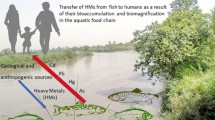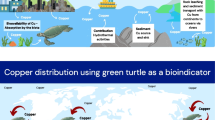Abstract
In the present study, we report the concentrations of 21 trace elements (V, Cr, Mn, Co, Cu, Zn, As, Se, Rb, Sr, Mo, Ag, Cd, Sn, Sb, Cs, Ba, Hg, Tl, Pb, and Bi), as well as the results of the analysis of stable carbon and nitrogen isotopes, of the various biota that make up the food web in the main stream of the Mekong Delta near Can Tho, South Vietnam. A significant trophic level-dependent increase was found in concentrations of Se, Rb, and Hg with increasing δ15N, indicating that an overall biomagnification of these elements occurred. However, the increase of Hg concentration per trophic level was lower than in previous studies. In contrast, the concentration of Mn showed an opposite trend in the food web of the Mekong Delta. In addition to these overall trends, the present study revealed that the biomagnification profiles of trace metals differ between crustaceans and fishes; concentrations of Mn, Cu, Zn, As, Sr, Mo, Ag, Cd, Sb, Cs, Ba, Tl, and Pb were significantly higher in crustaceans, whereas fishes showed higher concentrations of Cr, Rb, and Hg (trophic level determined by δ15N). The differences in the biomagnification profile between the major taxa might be attributed to differences in metal accumulation and in detoxification abilities such as possessing a metal-binding protein, e.g., metallothionein (MT).




Similar content being viewed by others
References
Agusa T, Kunito T, Nakashima E, Minh TB, Subramanian A, Viet PH (2003) Preliminary studies on trace element contamination in dumping sites of municipal wastes in Indian and Vietnam. J Phys IV 107:21–24
Agusa T, Kunito T, Fujihara J, Kubota R, Minh TB, Trang PTK, Iwata H, Subramanian A, Viet PH, Tanabe S (2006) Contamination by arsenic and other trace elements in tube-well water and its risk assessment to humans in Hanoi, Vietnam. Environ Pollut 139:95–106
Ahearn GA, Mandal PK, Mandal A (2004) Mechanisms of heavy-metal sequestration and detoxification in crustaceans: a review. J Comp Physiol B 174:439–452
Amiard JC, Amiard-Triquet C, Barka S, Pellerin J, Rainbow PS (2006) Metallothioneins in aquatic invertebrates: their role in metal detoxification and their use as biomarkers. Aquat Toxicol 76:160–202
Arai T, Ikemoto T, Hokura A, Terada Y, Kunito T, Tanabe S, Nakai I (2004) Chemical forms of mercury and cadmium accumulated in marine mammals and seabirds as determined by XAFS analysis. Environ Sci Technol 38:6468–6474
Atwell L, Hobson KA, Welch HE (1998) Biomagnification and bioaccumulation of mercury in an arctic marine food web: insights from stable nitrogen isotope analysis. Can J Fish Aquat Sci 55:1114–1121
Barceloux DG (1999) Manganese. Clin Toxicol 37:293–307
Binz PA, Kägi JHR (1999) Metallothionein: molecular evolution and classification. In: Klaassen C (ed) Metallothionein IV. Birkhäuser Verlag, Basel, Switzerland, pp 7–13
Brouwer M, Syring R, Brouwer TH (2002) Role of a copper-specific metallothionein of the blue crab, Callinectes sapidus, in copper metabolism associated with degradation and synthesis of hemocyanin. J Inorg Biochem 88:228–239
Brown BE (1982) The form and function of metal-containing ‘granules’ in invertebrate tissues. Biol Rev 57:621–667
Cabana G, Rasmussen JB (1994) Modelling food chain structure and contaminant bioaccumulation using stable nitrogen isotopes. Nature 372:255–257
Cabana G, Rasmussen JB (1996) Comparison of aquatic food chains using nitrogen isotopes. Proc Natl Acad Sci USA 93:10844–10847
Campbell LM, Norstrom RJ, Hobson KA, Muir DCG, Backus S, Fisk AT (2005a) Mercury and other trace elements in a pelagic Arctic marine food web (Northwater Polynya, Baffin Bay). Sci Total Environ 351–352:247–263
Campbell LM, Fisk AT, Wang X, Köck G, Muir DCG (2005b) Evidence for biomagnification of rubidium in freshwater and marine food webs. Can J Fish Aquat Sci 62:1161–1167
Cole ML, Valiela I, Kroeger KD, Tomasky GL, Cebian J, Wigand C, McKinney RA, Grady SP, Carvavlho da Silva MH (2004) Assessment of a δ15N isotopic method to indicate anthropogenic eutrophication in aquatic ecosystems. J Environ Qual 33:124–132
DeNiro MJ, Epstein S (1981) Influence of diet on the distribution of nitrogen isotopes in animals. Geochim Cosmochim Acta 45:341–351
Hobson KA, Welch HE (1992) Determinatin of trophic relationships within a high Arctic marine food web using δ13C and δ15N analysis. Mar Ecol Prog Ser 84:9–18
Ikebe K, Nishimune T, Tanaka R (1991) Contents of 17 metal elements in food determined by inductively coupled plasma atomic emission spectrometry: fish and shellfishes. Syokueishi (J Food Hyg Soc Japan) 32:336–350; (in Japanese)
Ikemoto T, Kunito T, Tanaka H, Baba N, Miyazaki N, Tanabe S (2004) Detoxification mechanism of heavy metals in marine mammals and seabirds: interaction of selenium with mercury, silver, copper, zinc, and cadmium in liver. Arch Environ Contam Toxicol 47:402–413
Itano K, Kawai S, Tatsukawa R (1985) Properties of mercury and selenium in salt-insoluble fraction of muscles in striped dolphin. Bull Jpn Soc Fish 51:1129–1131
Iwata H, Agusa T, Inoue S, Kubota R, Minh NH, Minh TB, Tu NPC, Kajiwara N, Kunisue T, Subramanian A, Tanabe S, Viet PH, Tuyen BC (2004) Contamination of trace elements in ground water and persistent organochlorines in sediment from Mekong Delta, South Vietnam. In: Proceedings of International Symposium on the development of water resource management system in Mekong Watershed, 3–4 December 2004, Hanoi, Vietnam, pp 25–31
Jarman WM, Hobson KA, Sydeman WJ, Bacon CE, McLaren EB (1996) Influence of trophic position and feeding location on contaminant levels in the Gulf of the Farallones food web revealed by stable isotope analysis. Environ Sci Technol 30:654–660
Kidd KA, Schindler DW, Muir DCG, Lockhart WL, Hesslein RH (1995a) High concentrations of toxaphene in fishes from a subarctic lake. Science 269:240–241
Kidd KA, Hesslein RH, Fudge RJP, Hallard KA (1995b) The influence of trophic level as measured by δ15N on mercury concentration in freshwater organisms. Water Air Soil Pollut 80:1011–1015
Kidd KA, Stern G, Lemoalle J (2004) Mercury and other contaminants in fish from Lake Chad, Africa. Bull Environ Contam Toxicol 73:249–256
Kim EY, Murakami T, Saeki K, Tatsukawa R (1996) Mercury levels and its chemical form in tissues and organs of seabirds. Arch Environ Contam Toxicol 30:259–266
Kubota R, Kunito T, Tanabe S (2001) Arsenic accumulation in the liver tissue of marine mammals. Environ Pollut 115:175–197
Lin TS, Nriagu J (1999) Thallium speciation in the Great Lakes. Environ Sci Technol 33:3394–3397
Lin TS, Nriagu J, Wang XQ (2001) Thallium concentration in lake trout from Lake Michigan. Bull Environ Contam Toxicol 67:921–925
Mackintosh CE, Maldonado J, Hongwu J, Hoover N, Chong A, Ikonomou MG, Gobas FAPC (2004) Distribution of phthalate esters in a marine aquatic food web: comparison to polychlorinated biphenyls. Environ Sci Technol 38:2011–2020
MAFF (2000) Monitoring and surveillance of non-radioactive contaminants in the aquatic environment and activities regulating the disposal of wastes at sea, 1997. In: Aquatic Environment Monitoring Report No. 52. Center for Environment, Fisheries and Aquaculture Science, Lowestoft, UK
Minh NH, Minh TB, Watanabe M, Kunisue T, Monirith I, Tanabe S, Sakai S, Subramanian A, Sasikumar K, Viet PH, Tuyen BC, Tana T, Prudente M (2003). Open dumping site in Asian developing countries: a potential source of polychlorinated dibenzo-p-dioxins and polychlorinated dibenzofurans. Environ Sci Technol 37:1493–1502
Minagawa M, Wada E (1984) Stepwise enrichment of 15N along food chains: further evidence and the relation between δ15N and animal age. Geochim Cosmochim Acta 48:1135–1140
Moisey J, Fisk AT, Hobson KA, Norstrom RJ (2001) Hexachlorocyclohexane (HCH) isomers and chiral signatures of δ-HCH in the Arctic marine food web of the Northwater Polynya. Environ Sci Technol 35:1920–1927
Monirith I, Ueno D, Takahashi S, Nakata H, Sudaryanto A, Subramanian A, Karuppiah S, Ismail A, Muchtar M, Zheng J, Richardson BJ, Prudente M, Hue ND, Tana TS, Tkalin AV, Tanabe S (2003) Asia-Pacific mussel watch: monitoring contamination of persistent organochlorine compounds in coastal waters of Asian countries. Mar Pollut Bull 46:281–300
Morel FMM, Kraepiel AML, Amyot M (1998) The chemical cycle and bioaccumulation of mercury. Annu Rev Ecol Syst 29:543–566
Nam DH, Anan Y, Ikemoto T, Okabe Y, Kim EY, Subramanian A, Saeki K, Tanabe S (2005) Specific accumulation of 20 trace elements in great cormorants (Phalacrocorax carbo) from Japan. Environ Pollut 134:503–514
Neal C, Robson AJ (2000) A summary of river water quality data collected within the land-ocean interaction study: core data for eastern UK rivers draining to the North Sea. Sci Total Environ 251/252:585–665
Neal C, Neal M, Hill L, Wickham H (2006) River water quality of the River Cherwell: an agricultural clay-dominated catchment in the upper Thames Basin, southeastern England. Sci Total Environ 360:272–289
Nordstrom DK (2002) Worldwide occurrences of arsenic in ground water. Science 296:2143–2145
Okuda N, Hamaoka H, Fukumoto T, Miyasaka H, Omori K (2004) How to monitor the coastal food-web dynamics using stable-isotope analysis of higher consumers. In: Proceedings of International Symposium on Long-term Variations in the Coastal Environments and Ecosystems, 27–28 September 2004, Matsuyama, Japan, pp 200–205
Peterson BJ, Fry B (1987) Stable isotopes in ecosystem studies. Ann Rev Ecol Syst 18:293–320
Howarth RW, Garritt RH (1985) Multiple stable isotopes used to trace the flow of organic matter in estuarine food webs. Science 227:1361–1363
Petri G, Zauke GP (1993) Trace metal in the crustaceans in the Antarctic Ocean. Ambio 22:529–536
Pourang N, Dennis JH, Ghourchian H (2004) Tissue distribution and redistribution of trace elements in shrimp species with the emphasis on the roles of metallothionein. Ecotoxicology 13:519–533
Quinn MR, Feng X, Folt CL, Chamberlain CP (2003) Analyzing trophic transfer of metals in stream food webs using nitrogen isotopes. Sci Total Environ 317:73–89
Rainbow PS (1996) Heavy metals in aquatic invertebrates. In: Beyer WN, Heinz GH, Redmon-Norwood AW (eds) Environmental contaminants in wildlife: interpreting tissue concentrations. CRC Press, Boca Raton, FL, pp 357–376
Rainer J, Brouwer M (1993) Hemocyanin synthesis in the blue crab callinectes sapidus. Comp Biochem Physiol 104B:69–73
Stanger G, VanTruong T, Ngoc KSLTM, Luyen TV, Thanh TT (2005) Arsenic in groundwaters of the Lower Mekong. Environ Geochem Health 27:341–357
Stewart AR, Luoma SN, Schlekat CE, Doblin MA, Hieb KA (2004) Food web pathway determines how selenium affects aquatic ecosystems: a San Francisco Bay case study. Environ Sci Technol 38:4519–4526
Suedel BC, Boraczek JA, Peddicord RK, Clifford PA, Dillon TM (1994) Trophic transfer and biomagnification potential of contaminants in aquatic ecosystems. Rev Environ Contam Toxicol 136:21–89
Viers J, Barroux G, Pinelli M, Seyler P, Oliva P, Dupré B, Boaventura GR (2005) The influence of the Amazonian floodplain ecosystems on the trace element dynamics of the Amazon River mainstem (Brazil). Sci Total Environ 339:219–232
Watanabe I, Shinomiya M, Kunito T, Tanabe S, Kubodera T (2002) Trace element accumulation in deep sea organisms from Suruga Bay and off Tohoku in the western North Pacific, Japan. Chikyukagaku (Geochemistry) 36:179–189; (in Japanese with English summary)
Watanabe I, Tanabe S (2003) Trace element accumulation in 20 species of fishes from Lake Baikal, Caspian Sea, Black Sea and Japanese coastal waters. Kankyoukagaku (J Environ Chem) 13:31–40; (in Japanese with English summary)
WHO (1996) Guidelines for Drinking Water Quality. 2nd edition. Geneva: World Health Organization International Program on Chemical Safety 156–167
Yoshinaga J, Suzuki T, Hongo T, Ninagawa M, Ohtsuka R, Kawabe T, Inaoka T, Akimichi T (1992) Mercury concentration correlates with the nitrogen stable isotope ratio in the animal food of Papuans. Ecotoxicol Environ Saf 24:37–45
Acknowledgments
We are grateful to Dr T. Komai for identifying the crustaceans. The study was supported by a grant from Research Revolution 2002 (RR2002) of the Project for Sustainable Coexistence of Human, Nature and Earth (FY2002) from the Ministry of Education, Culture, Sports, Science and Technology, Japan and by a Grant-in-Aid for Scientific Research from the Japan Society for Promotion of Science (no. 16310042).
Author information
Authors and Affiliations
Corresponding author
Rights and permissions
About this article
Cite this article
Ikemoto, T., Tu, N.P.C., Okuda, N. et al. Biomagnification of Trace Elements in the Aquatic Food Web in the Mekong Delta, South Vietnam Using Stable Carbon and Nitrogen Isotope Analysis. Arch Environ Contam Toxicol 54, 504–515 (2008). https://doi.org/10.1007/s00244-007-9058-5
Received:
Accepted:
Published:
Issue Date:
DOI: https://doi.org/10.1007/s00244-007-9058-5




